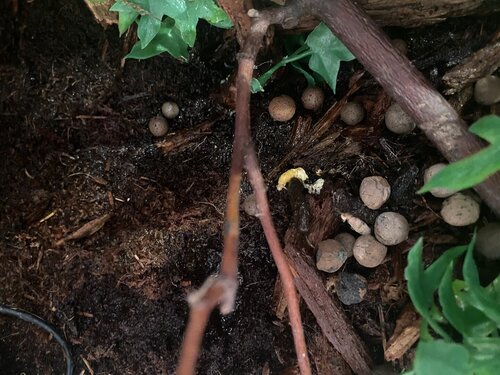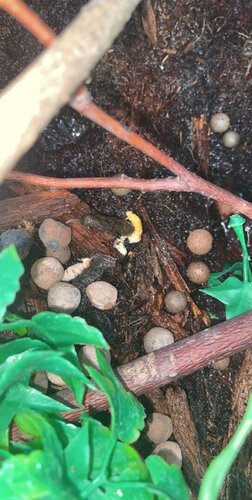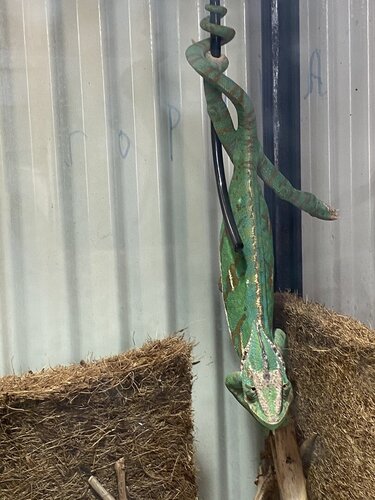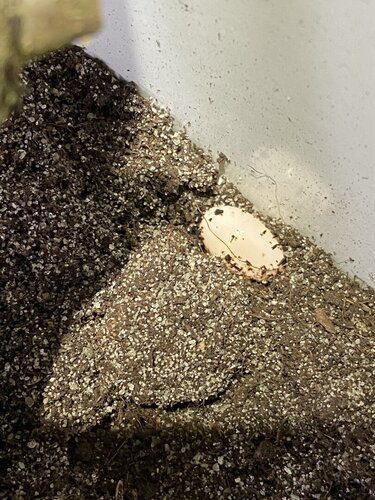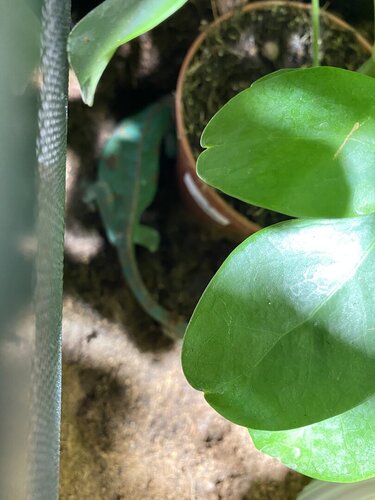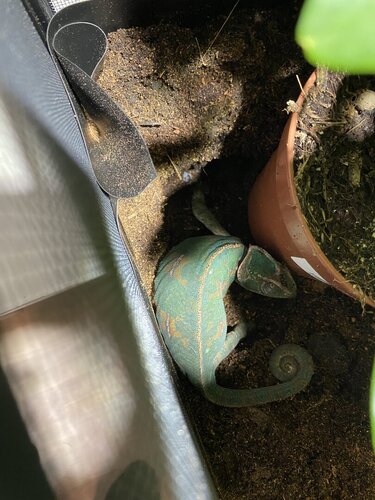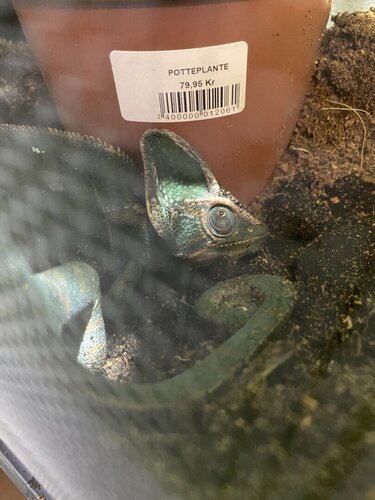Navigation
Install the app
How to install the app on iOS
Follow along with the video below to see how to install our site as a web app on your home screen.
Note: This feature may not be available in some browsers.
More options
You are using an out of date browser. It may not display this or other websites correctly.
You should upgrade or use an alternative browser.
You should upgrade or use an alternative browser.
Is she dehydrated?
- Thread starter malle000999
- Start date
Take a pic if you can... Then we can actually tell.I just checked and it’s like white with a yellow kind of layer
malle000999
Member
I have just answered themyou asked..."is it unhealthy for her to be hefty?"... Yes it is. If a female veiled is overweight she will lay a huge clutch instead of a normal sized one which means she needs more nutrients to put in the eggs and more calcium for he shell. Usually they develop MBD and can prolapse, become eggbound, lose muscle strength and have other issues....somtheynusualy die.
If you don't provide a proper place for her to lay eggs if/when she produces them she will likely become eggbound and die unless you catch it in time and get her spayed. It isn't always easy to tell when they are ready to lay the eggs so waiting until you think it's time might result in you missing it and her becoming egg bound.
Please answer the questions @Ruthless asked you to answer so we can see that you have your husbandry right and hopefully prevent problems from happening. Please be very specific about the answers...especially for the supplements and lists you are using.
malle000999
Member
This is her Old cage she doesn’t live in it anymore and yes im aware that it’s way to wet I have that under control.?Take a pic if you can... Then we can actually tell.
Attachments
malle000999
Member
Thank you so much I never realized!?Yeah avoid spraying her... hand held sprayers have a harder mist to them. They are not like a mist king automated mister that has a very very fine spray. Chams will go into mist if they want to. They do not like being sprayed directly. It is shocking for them. Also they are dry shedders so if you are spraying her and she starts a shed she will have issues shedding properly because it actually sticks the shed to their skin.
snitz427
Chameleon Enthusiast
As others have said, more food means more eggs. I would put her on a diet right away. Not necessarily to lose weight, but to keep her from producing more eggs.
I keep my 3 girls on the cooler side, usually around 80-82 in the basking spot... and 75ish everywhere else. I feed them every Tues, Thurs, Sat... 3-5 moderately sized feeders. My adult veiled gets maybe 3-4 medium (dime sized) dubia, and maybe a superworm or two, or the equivalent. We rotate a lot of diff bugs but try to stick to that size of a meal.
My 2 panthers are now 1 year old and neither have laid a clutch yet. My veiled is 1.5 years old and she’s a machine. She regularly lays about every 4-6 months... but she has never been very big/ chunky when gravid.
Keeping slightly cooler temps and feeding the minimum helps them to focus on their own needs rather than put all their nutrients and energy into producing eggs.
My girls have bioactive cages so they can lay anytime they need to. Clarice tends to tunnel down behind plant roots or cork bark so that her babies are hidden from view.
I keep my 3 girls on the cooler side, usually around 80-82 in the basking spot... and 75ish everywhere else. I feed them every Tues, Thurs, Sat... 3-5 moderately sized feeders. My adult veiled gets maybe 3-4 medium (dime sized) dubia, and maybe a superworm or two, or the equivalent. We rotate a lot of diff bugs but try to stick to that size of a meal.
My 2 panthers are now 1 year old and neither have laid a clutch yet. My veiled is 1.5 years old and she’s a machine. She regularly lays about every 4-6 months... but she has never been very big/ chunky when gravid.
Keeping slightly cooler temps and feeding the minimum helps them to focus on their own needs rather than put all their nutrients and energy into producing eggs.
My girls have bioactive cages so they can lay anytime they need to. Clarice tends to tunnel down behind plant roots or cork bark so that her babies are hidden from view.
malle000999
Member
Thank you I will do that right away, I never even thought about chameleons could be overweight but now I know. I guess the seller didn't think about that either.As others have said, more food means more eggs. I would put her on a diet right away. Not necessarily to lose weight, but to keep her from producing more eggs.
I keep my 3 girls on the cooler side, usually around 80-82 in the basking spot... and 75ish everywhere else. I feed them every Tues, Thurs, Sat... 3-5 moderately sized feeders. My adult veiled gets maybe 3-4 medium (dime sized) dubia, and maybe a superworm or two, or the equivalent. We rotate a lot of diff bugs but try to stick to that size of a meal.
My 2 panthers are now 1 year old and neither have laid a clutch yet. My veiled is 1.5 years old and she’s a machine. She regularly lays about every 4-6 months... but she has never been very big/ chunky when gravid.
Keeping slightly cooler temps and feeding the minimum helps them to focus on their own needs rather than put all their nutrients and energy into producing eggs.
My girls have bioactive cages so they can lay anytime they need to. Clarice tends to tunnel down behind plant roots or cork bark so that her babies are hidden from view.
If she had eggs 3 months ago she could have another clutch in a month or so....and will continue to if she is maintained the same way she has been maintained in the 3 months before the last clutch.* Your Chameleon - The species, sex, and age of your chameleon. How long has it been in your care?
- veiled chameleon
- female
- in my care 5 days
- age 9 month
* Handling - How often do you handle your chameleon?
- I haven’t Handel her only hand feed
* Feeding - What are you feeding your cham? What amount? What is the schedule? How are you gut-loading your feeders?
- grasshoppers about 5-6 every other day
You can add hornworms (that you buy that are not from your garden), roaches, silkworms, BSFL, crickets and once in a while, waxworms, superworms, etc.
-I feed my feeders weeds from my yard or oats or cucumber
Please don't use oats. You can feed them dandelion greens, kale, collards, squash, sweet red pepper, sweet potato, etc.
* Supplements - What brand and type of calcium and vitamin products are you dusting
your feeders with and what is the schedule?
-calsium and d3 2 times a week
-with nekton
Does the nekton have prEformed (retinol, retinyl, retinal) vitamin A in it? It's recommended that you dust lightly with a phos free calcium powder at most feedings. It's redommended that you dust lightly with a phos free calcium/D3 powder and twice a month with a vitamin powder that contains a beta carotene prOformed source of vitamin A.
* Watering - What kind of watering technique do you use? How often and how long to you mist? Do you see your chameleon drinking?
- no I don’t see her drinking
- I have a dripper and it’s always on except at night
-I mist about 30 seconds 3-5 times a day
* Fecal Description - Briefly note colors and consistency from recent droppings. Has this chameleon ever been tested for parasites?
- I don’t know if she has been tested the seller did not tell me
-she is normally dark green with white spots
But know she is light green with orange/brown stripes
-her poop is fine with the little yellow/white thing
* History - Any previous information about your cham that might be useful to others when trying to help you.
- she laid eggs 3 month ago
Cage Info:
* Cage Type - Describe your cage (Glass, Screen, Combo?) What are the dimensions?
-screen cage 61 cm 61 cm 122cm
* Lighting - What brand, model, and types of lighting are you using? What is your daily lighting schedule?
-HID with a uv-b light
The most often recommended UVB light is the reptisun 5.0 long linear tube light. For basking you can use a regular household incandescent bulb of a wattage that produces a temperature in the low to mid 80's F. No colored lights and no lights at night of course.
* Temperature - What temp range have you created (cage floor to basking spot)? Lowest overnight temp? How do you measure these temps?
-a spot with 30° and the bottom 22° and the rest is 25°
* Humidity - What are your humidity levels? How are you creating and maintaining these levels? What do you use to measure humidity?
- I don’t know the humidity
* Plants - Are you using live plants? If so, what kind?
- I use live plants all chameleon safe
* Placement - Where is your cage located? Is it near any fans, air vents, or high traffic areas? At what height is the top of the cage relative to your room floor?
-located in my room by my door next to a window
- about 50 cm from the roof
I would move the cage away from the window. She can get a draft in the winter.
* Location - Where are you geographically located?
-location is in Denmark
Current Problem - The current problem you are concerned about.
- eggs, dehydrated, and weight!
malle000999
Member
Okay i will move her away from the window,If she had eggs 3 months ago she could have another clutch in a month or so....and will continue to if she is maintained the same way she has been maintained in the 3 months before the last clutch.
I feed some of my worms with oats because that is what they eat in Denmark we don’t have hornworms and waxworks I do feed her cockroaches and crickets and grasshoppers
I don’t think she’s overweight she change from day to day with her body.
Attachments
malle000999
Member
Thatwizard420
Chameleon Enthusiast
that looks like an egg...I’m not sure the seller didn’t say. But I think she laid an egg, but there’s only one. Is this an egg?
When they're laying you gotta cover them and don't look at here. She will stop laying and can become eggbound.
Its best to trow a towel on the cage and just let her do her business privately
Gladius79
New Member
What hand mister has the finest mist?Yeah avoid spraying her... hand held sprayers have a harder mist to them. They are not like a mist king automated mister that has a very very fine spray. Chams will go into mist if they want to. They do not like being sprayed directly. It is shocking for them. Also they are dry shedders so if you are spraying her and she starts a shed she will have issues shedding properly because it actually sticks the shed to their skin.
There is not one that is specifically better in hand misters. All of them have a cheap nozzle with a harsher mist spray. I recommend an automated mistking starter system.What hand mister has the finest mist?
IMHO...the time to cut the food back is after she lays the clutch...cutting back while she's gravid IMHO is going to affect her ability to produce the eggs she's working in now and keep herself healthy. There are lots of nutrients going into the eggs. I never have had a female lay hug clutches but when my females are producing a clutch I don't cut her back then....I let her lay the clutch and then feed her well for 2 feedings and then cut her back. It's just the way that works for me so I continue to do it.
malle000999
Member
I really need help, I put her nesting bin in with a plant so she can have privacy and there are two sticks that go into the bin. But she has laid 4 eggs in her plant and right now she crawled to the bottom and started digging and there is about 10 cm soil what can I do to get her in the nesting bin? When she finds out there’s not enough soil will she still lay the eggs? The nesting bin is 21 cm wide and 28 cm deep she’s just scratching the floor of the cage...IMHO...the time to cut the food back is after she lays the clutch...cutting back while she's gravid IMHO is going to affect her ability to produce the eggs she's working in now and keep herself healthy. There are lots of nutrients going into the eggs. I never have had a female lay hug clutches but when my females are producing a clutch I don't cut her back then....I let her lay the clutch and then feed her well for 2 feedings and then cut her back. It's just the way that works for me so I continue to do it.
malle000999
Member
I really need help, I put her nesting bin in with a plant so she can have privacy and there are two sticks that go into the bin. But she has laid 4 eggs in her plant and right now she crawled to the bottom and started digging and there is about 10 cm soil what can I do to get her in the nesting bin? When she finds out there’s not enough soil will she still lay the eggs? The nesting bin is 21 cm wide and 28 cm deep she’s just scratching the floor of the cage...
Attachments
malle000999
Member
I finally got her in her nesting bin I use none fertilized soil, and it’s mixed with sand. she spend all day yesterday making a cage and then I woke up to her cage being collapsed. So now she’s starting again. And I’m thinking that it’s to dry but I can’t do anything about it now because she’s in there and won’t come out not even to drink and she let me see her drink yesterday. What do I do?What substrate did you use for the laybin?
Is she still digging?
Similar threads
- Replies
- 13
- Views
- 395
- Replies
- 3
- Views
- 266





